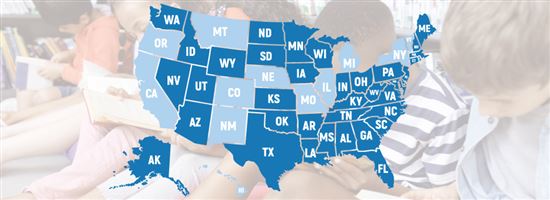How to Use a 529 Plan for Private School
529 plans aren't just for college. Find out below how to use the funds for your children's private elementary and high school education.
 |
Maybe you've been putting your 529 plan on the back burner since college is still years away for your child. But, ever since the 2017 tax reform, 529 plans can be used for more than just higher education.
Now, you can use 529 plans for private elementary, middle, and high school tuition—up to $10,000 per year.
Learn more about the 529 plan and whether you should invest and dip into that cash earlier.
What Is a 529 Plan?
 |
A 529 plan is a tax-advantaged investment account similar to an IRA. It lets you save money for higher education expenses. You can now use it for private primary and secondary school tuition too.
Most plans let you set it and forget it. Automatic deposits can be set up from your checking account or via a payroll deduction.
The money in the account is managed by an outside investment firm hired by the program manager or the state treasurer's office. These plans are a very hands-off way to save for college.
When you need to use it, simply withdraw the funds and transfer them to your checking account. From there, it's cash you can put toward your child's education.
What Does a 529 Plan Cover?
 |
529 accounts are a great way for parents to invest in their children's education. What can you actually use the funds for? It depends on when you use them.
For higher education, 529 funds can be used for a variety of qualified expenses.
On the other hand, funds can only be used for private primary and secondary school tuition—no school supplies, books, or field trips.
The limit for withdrawals is $10,000 per year when used for private school tuition, and earnings and withdrawals are tax-free.
How to Open a 529 Plan
Each state has its own 529 plan, and you can invest in any of them. It's best to check out your state's plan first, since more than 30 states offer a tax deduction for contributions to the plan.
If plan fees are high in your state, that's when you might want to look for out-of-state plans for a better deal.
Check out this tool to view your state tax benefits and compare plans nationwide:
Whether you can use your 529 for homeschooling depends on your state laws. Some states actually consider homeschooling as private schooling.
Who Should Use a 529 Plan for Private School?
 |
Don't rush out to withdraw money from your child's 529 plan to pay for his or her private school tuition just because you can. Part of the benefit of these plans is that the money has many years to grow.
A 529 plan is meant to be a relatively long-term investment. But there are some circumstances where using it for K-12 can make financial sense:
Need Money in a Pinch
If your family's income gets impacted while your kids are already enrolled in private school, consider using that 529 money. It can be an excellent way to avoid the upheaval of pulling your kids out of their current school.
More Than Enough Saved for College
Saving too much money is never a bad thing! But for various reasons, you may have a lot more money in your 529 plan than will be necessary for college.
For example, your child could get lots of scholarships, or they may choose a less expensive college than you had anticipated. If this is the case for your student, you can make withdrawals to pay for private school tuition to help drain the account without paying the penalty.
Keep in mind that you can also change the beneficiary. If you have another college-bound child, you can always transfer over your funds.
Take Advantage of Tax Benefits
Many states provide a tax deduction or credit when you use the plan administered by your home state.
Contributions to a 529 plan are considered gifts. For 2020, gifts up to $15,000 per person qualify for the annual gift tax exclusion. The $15,000 gift tax exclusion amount also includes any other cash or property gifts in addition to 529 plan contributions.
Currently, more than 30 states provide these tax benefits. Families in Arizona, Kansas, Minnesota, Missouri, Montana, and Pennsylvania are even eligible for tax deduction for making contributions to any state's 529 plan.
Find Out How Your State's 529 Plan Works
 |
Federal laws have expanded 529 plans to include private K-12 education. Still, not every state has updated their tax laws to do the same.
What does that mean for you? The federal government won't tax the 529 money you use for private school tuition—but your state government might.
Here are the states that do not conform to federal 529 plan laws for elementary and high school use:
- California
- Colorado
- Hawaii
- Illinois
- Michigan
- Minnesota
- Montana
- Nebraska
- New Mexico
- New York
- Oregon
- Vermont
Always make sure you double-check your states laws before you use your 529 plan money.
If it's starting to look like your child isn't going to use all the funds, you can change the beneficiary to another child, family member, or even yourself.
As another option, you could take the cash—but you'll pay for it. You'll have to pay income taxes and take a 10% penalty on all earnings.
Other Factors to Consider
Impact on Long-Term Savings
Before you dip into that 529 for K-12 education, make sure you're on track for college savings. Always make sure to keep your long-term savings goals in mind, especially since college will probably be more expensive than primary or secondary school.
Gift Tax Limits
Every year, both you and your spouse can each contribute up to $15,000 per child without triggering gift taxes.
You can also front load your 529 for up to five years, or $75,000, at once without gift taxes. That goes for each spouse filing jointly, so you can both contribute up to $150,000 every five years.
Investment Allocation
If you plan to use some of your 529 funds prior to college, you might want to take a more conservative investing approach. Stable investments will be a safer bet to be able to access your money in the nearer term.
Plan Fees
A 529 can be a great financial tool, but every plan has different costs. Be sure to research and compare fees and investment options to find the right plan for you.
Bottom Line
If you already plan to enroll your kids in a private school, a 529 can be a good idea. On the other hand, you can just use it for college if you didn't plan for private elementary and high school.
For those who can afford to save a little more for education, the tax advantages make the 529 an extra helpful tool. It all comes down to what makes sense for your family's financial situation.
Whatever you decide, it's important that you know all your options when it comes to investing in your child's education and future.
Donna Tang is a content associate at CreditDonkey, a personal finance comparison and reviews website. Write to Donna Tang at donna.tang@creditdonkey.com. Follow us on Twitter and Facebook for our latest posts.
Read Next:





